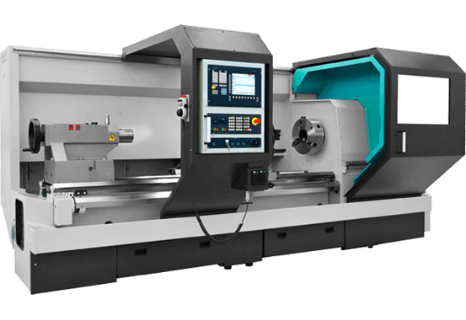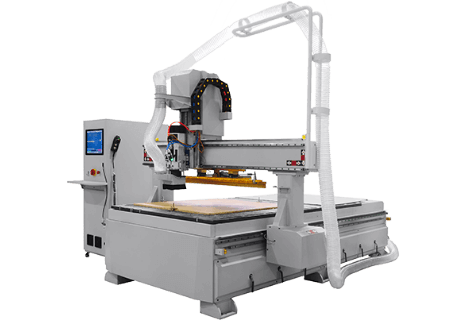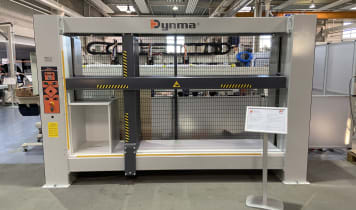Veneering machines
Most woodworking presses are simply different forms of the veneering press, which acts as a catch-all term for all machines used to press external veneers or similar coating materials onto wooden or chipboard workpieces.
Through-feed presses
Through-feed presses (continuous presses) are used in the chipboard industry. They press the coating materials onto the pre-fabricated chipboard in a continual procedure using heated rollers which securely attach the panels to the base item as they are fed through. Through-feed presses are production machines intended for high cycle rates and work at their best when performing the same procedure over large series.
Daylight presses
Daylight presses (multi-platen presses) are the smaller version of through-feed presses and are also used to coat chipboard with veneer. In contrast to large hot roller presses, daylight presses are only capable of processing small quantities.
Daylight presses feature a layered design with each press, or ‘daylight’, stacked on top of one another. Multi daylight presses make it possible to customise the production line, i.e. some chipboard panels can be veneered with one material while other panels receive a different layer. Synchronous coating of several panels also enables excellent productivity making multi daylight presses an ideal choice for mid-sized carpentry operations.
Press brakes
Daylight- and through-feed presses are only suited to coating processes on the upper- and lower-side of a panel – the edges cannot be worked on. They are also unsuitable for coating wooden profiles and this is why press brakes were developed. There are a variety of types available, each intended for a different specific application.
Simple press brakes work according to the same principle as the through-feed press: they adhere veneer strips along the edge of a panel or profile using heated rollers. The edges do not need to be straight or at a right angle to the panel or profile.
When it comes to layered edges, post-forming machines are the ideal choice. These technically-complex machines are specially designed for gluing layers onto strongly contoured edges.
The veneering of edges featuring radii is another matter entirely, which is why industry developed the soft-forming machine whose pressing roller is flexible and corresponds to the contour. It is thanks to these machines that individually-shaped edges and profiles can be created while remaining affordable to the consumer.
Membrane presses
Membrane presses were invented for coating strongly contoured surfaces but can only use flexible coating materials. Wooden veneers are unsuitable for application using a membrane press since they are at risk of splintering and breaking along the contours.
A membrane press consists of a large work table fitted with a membrane flap onto which the workpiece and coating material are placed. The membrane flap then closes and extracts the air between membrane and table and compressed air presses the coating material securely onto the workpiece. Due to their design and method of working, membrane presses are also known as 3D presses or vacuum presses.
Gluing presses
Pressing machines for woodworking are also used for the assembly of carcasses. Once coated, drilled and fitted with dowels, chipboard panels and profiles can be assembled together on these machines and transformed into usable products.
Carcass presses are used in the field of furniture building. They can continually produce furniture components with consistent quality to ensure later assembly work only requires a couple of manual interventions.
Frame presses are mostly used for window construction. They produce perfectly fitting frames for windows with consistent quality. Only by using modern frame presses can complex, thermally-insulated windows with double- and triple-glazing be produced at an affordable price.



















